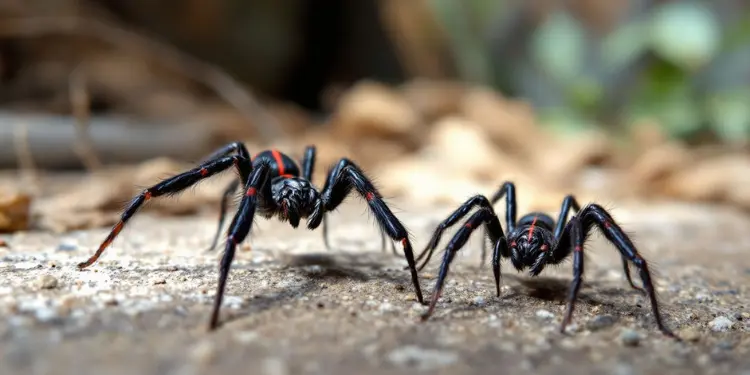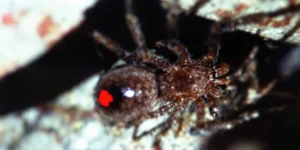Spiders can be frightening, but which ones pose a genuine threat? Many people confuse redback spider black widow. Comparing redback spiders and black widows is essential for safety.
Both spiders possess potent venom that can harm humans. This blog will help you distinguish between them and stay safe. Are you interested in learning more?
Key Takeaways
- Redback spiders and black widows are both deadly, with venom that can harm humans. Redbacks are native to Australia, while black widows are from North America.
- Female redbacks are slightly bigger than black widows, at 10 mm long. Both spiders’ venom contains alpha-latrotoxin, which causes severe pain and other symptoms.
- Redbacks have spread to new places like New Zealand (1980s), UAE (1990), and Japan (2008). They can live without food for up to 100 days and survive in temps from below freezing to 40°C.
- To stay safe, keep your garden tidy, check shoes before wearing, and use gloves when gardening. If bitten, stay calm and get medical help fast. About 250 cases need antivenom each year.
- Female redbacks can live for 2-3 years, much longer than males who only live 6-7 months. Redback spiderlings spread out by “ballooning” on silk threads.

Taxonomy and Naming

The redback spider, Latrodectus hasselti, is part of the widow spider family. Tamerlan Thorell first described this species in 1870. It’s native to Australia and has been known there since at least 1850.
The redback belongs to the genus Latrodectus, which includes other widow spiders.
Redbacks can breed with katipō spiders in Western Australia. This mix creates hybrid offspring. The name “redback” comes from the bright red stripe on the female’s back. Scientists use this mark to tell redbacks apart from other widow spiders.
Physical Appearance
Redback spiders have a distinctive appearance. Female redbacks are the most noticeable. They measure approximately 10 mm in length, with glossy black bodies. A vivid red stripe extends along their back, resembling a vibrant racing stripe.
Their underside features a red hourglass-shaped marking. This striking pattern serves as a warning to potential threats.
Male redbacks are considerably smaller and less conspicuous. They reach only 3-4 mm in length. Their bodies are light brown with white markings. They have a pale hourglass shape on their underside, though it’s not as prominent as the females’.
Newly hatched redbacks, known as spiderlings, are initially grey with dark spots. As young females develop, they acquire white markings before transitioning to black. These Australian arachnids are certainly eye-catching!
Distribution and Habitat
Redback spiders are native to Australia. They flourish in urban areas such as Brisbane, Perth, and Alice Springs. These spiders have adapted well to city environments and expanded their range.
They are now present in Southeast Asia, New Zealand, the UAE, Japan, and parts of the United States.
Research suggests redbacks originally inhabited arid regions of South and Western Australia. Their distribution has since expanded significantly. They established populations in New Zealand during the 1980s.
By 1990, they had reached the UAE. Japan recorded its first redback sightings in 2008. The adaptability of these spiders to new environments raises concerns for local ecosystems.
Behaviour and Diet
Redback spiders are nocturnal hunters. They construct irregular webs in dry, sheltered areas close to residences. Their webs feature a funnel-shaped retreat and adhesive strands that function as sensors.
These resourceful spiders capture various types of prey.
Insects comprise the majority of the redback’s diet. They also consume small animals such as lizards and mice. Occasionally, they even capture snakes. Mating poses a risk for male redbacks.
Approximately two-thirds of them are consumed by the females after mating. Female redbacks can store sperm for up to two years. This enables them to produce multiple batches of eggs over time.
Venom and Danger Level
Redback spiders possess a formidable venom. Their venom contains a combination of potent toxins that affect the nervous system. Those bitten experience intense pain, profuse sweating, and potential nausea.
The primary component of the venom is alpha-latrotoxin. This chemical is highly toxic to mice. It requires only 0.27–0.91 mg per kg of body weight to be lethal to 50% of them. Female redbacks contain approximately 0.08–0.10 mg of venom.
This amount is sufficient to cause severe illness in humans.
Fortunately, an antidote for redback bites exists. It has been available since 1956. Some research indicates it may not be as effective as previously thought. Simple analgesics might be equally beneficial.
Detailed Comparison Table
Our comprehensive comparison table highlights important distinctions between redback spiders and black widows. Review it to gain insights into these dangerous arachnids.
Size
Size is a key factor when comparing these two dangerous spiders. We can examine how the redback spider and black widow measure up.
| Spider | Female Size | Male Size |
|---|---|---|
| Redback Spider | 10 mm (1 cm or 0.4 inches) body length | 3-4 mm (0.12-0.16 inches) body length |
| Black Widow | 8-10 mm (0.3-0.4 inches) body length | 3-6 mm (0.12-0.24 inches) body length |
Female redbacks are slightly bigger than black widows. Male redbacks are smaller than male black widows. In both species, females are much larger than males. This size difference aids females in identifying potential mates. It also indicates that the female’s bite poses a greater risk to humans.
Venom Potency
Moving from size to venom potency, we examine the more dangerous aspect of these spiders. Both the redback and black widow have highly potent venom.
The venom potency of these spiders is remarkable. Here’s a comparison of their toxicity:
| Spider | Venom Potency | Key Toxin | Effects on Humans |
|---|---|---|---|
| Redback Spider | Highly toxic | Alpha-latrotoxin | Severe pain, sweating, nausea, vomiting |
| Black Widow | Highly toxic | Alpha-latrotoxin | Muscle cramps, abdominal pain, high blood pressure |
Both spiders use alpha-latrotoxin as their main toxin. This powerful substance affects nerve cells, causing intense pain and other symptoms. The LD50 (lethal dose for 50% of test subjects) of alpha-latrotoxin in mice is 0.27–0.91 mg/kg. For pure alpha-latrotoxin, it’s even lower at 20–40 μg/kg in mice.
Both redbacks and black widows use their venom mainly for hunting. The toxin quickly paralyses their prey, making it easy to eat. For humans, a bite is usually a defensive action when the spider feels threatened.
Despite their small size, these spiders’ venom is among the most potent in the world. It’s a clear indication of nature’s power in tiny packages. Always take care in areas where these spiders live to avoid painful encounters.
Geographic Distribution
The redback spider and black widow have different home ranges across the globe. Here’s where these spiders live:
| Spider | Geographic Distribution |
|---|---|
| Redback Spider |
– Native to Australia – Found in urban areas like Brisbane, Perth, and Alice Springs – Spread to Southeast Asia, New Zealand, UAE, Japan, and USA – In New Zealand since early 1980s – In UAE since 1990 – In Japan since 2008 |
| Black Widow |
– Native to North America – Found in temperate regions worldwide – Common in southern USA – Also in South America, Africa, and southern Europe |
Redback spiders have spread beyond Australia in recent years. They’ve made homes in new places like New Zealand and Japan. These spiders prefer warm spots and often live near humans. Black widows, on the other hand, stay mostly in North America. But they’ve also spread to warmer parts of other continents. Both spiders can thrive in urban settings, making it important to know how to spot them.
For more tips on spider safety, RedbackSpider.com’s guide on avoiding bites is available.
Typical Prey
Moving from where these spiders live, let’s examine their diet. Redback spiders and black widows consume similar prey. They primarily capture and eat insects, including flies, ants, and beetles. These spiders also catch larger prey. At times, they trap lizards, mice, and even small snakes. These spiders are adept hunters, using their strong webs to capture prey much larger than themselves.
Interesting Facts about the Redback Spider
Redback spiders are fascinating creatures with unique traits. Here are some interesting facts about these arachnids:
- Extended female lifespan: Female redback spiders can live for two to three years, significantly longer than males.
- Brief male lifespan: Male redbacks have a lifespan of only six to seven months.
- Dispersing spiderlings: Redback spiderlings spread out by “ballooning” on silk threads. They often cooperate to achieve this.
- Exceptionally adhesive silk: These spiders produce a special highly adhesive silk to capture prey. It’s remarkably strong and sticky.
- Temperature resilience: Redbacks can survive in temperatures from below freezing to 40°C. However, they require 15-25°C for reproduction.
Prevention and Safety Tips
Protecting yourself from redback spiders is essential. Here are some suggestions to help you avoid bites and remain safe:
- Maintain a tidy yard. Clear away piles of wood, rocks, and rubbish where spiders shelter.
- Check shoes and clothes before wearing them. Redbacks prefer dark, quiet areas.
- Use gloves when gardening or moving outdoor items. This protects your hands from bites.
- Close cracks and gaps in your home’s walls and floors. This prevents spiders from entering.
- Install screens on windows and doors. These stop spiders from coming into your house.
- Inspect dark corners and under furniture regularly. Remove any webs you find.
- Take extra care from December to April. Redback bites occur most frequently during these months.
Black Widow Spider in Australia: How It Compares to the Redback
Curious about the black widow spider in Australian settings? This post highlights spider vs spider insights, including a quick vs black widow look at local species. It’s worth reading because it examines each arachnid’s lifestyle, venomous impact, and first aid needs.
1. Black Widow Spider: Where Is It Found?
The black widow spider is part of the family theridiidae. Although these spiders are black with a shiny black finish, the Australian climate can influence their distribution. People sometimes see them near a shed or toilet.
2. Spider vs Redback: Are They Alike?
The redback spider and the black widow share similarities: both can bite humans, both are venomous, and each has an abdomen typically marked. The redback abdomen often shows a red dorsal stripe, while the black widow displays an hourglass marking.
3. vs Black Widow: Any Symptom Differences?
A bite from either spider may cause pain and swelling at the bite site. Nausea could arise if spider venom hits the digestive system. If a bite worsens, seek first aid promptly.
4. Symptom or Venomous Danger?
Their venom acts directly on the nerves, and these spiders are black with slender legs to move swiftly. Egg sacs may appear in corners of a nest. During winter months, activity often lowers.
5. First Aid for Bites
When a bite humans, apply first aid: wash the area, wrap a bandage, and watch for an allergic reaction. If severe, call triple zero.
6. Black Widow Spiders and Redback
Black widow spiders and redback counterparts share red markings on the upper side of the abdomen or have white markings on the upper region. Bites may be serious but rarely fatal.
7. Widow Spiders and Redback Spiders
Widow spiders and redback spiders hail from similar backgrounds. Male redback spiders can have a brownish abdomen, while females show a bright stripe on the upper portion.
8. Comparison Table: Key Traits
| Trait | Black Widow Spider | Redback Spider |
|---|---|---|
| Abdomen (Color) | Shiny black (Hourglass) | Dark with red markings |
| Typical Nest | Spin messy spider webs | Web near shelters (e.g., logs) |
| Climate Preferences | Warmer or temperate | Found across western australian areas |
Conclusion
Both redbacks and black widows are highly venomous spiders. These arachnids have numerous similarities, but also distinct characteristics. Redbacks are commonly found in Australian households, whereas black widows are prevalent in North America.
Recognising and steering clear of these spiders is crucial. Protect yourself by understanding these dangerous eight-legged creatures.
FAQs
1. Are Redback Spider Black Widow the same spider?
Nope, they’re different… but related. Both belong to the Latrodectus genus, but redbacks call Australia home, while black widows are found in North America. They’re cousins, you might say – deadly cousins.
2. Redback Spider Black Widow: Which spider packs a more potent punch?
It’s a close call, mate. Both spiders have venom that can make you crook. The redback’s bite might hurt more at first, but the black widow’s venom can spread faster through your body. Either way, you don’t want to test it out!
3. How can I tell these eight-legged nasties apart?
Look for the red stripe on the redback’s… well, back. It’s a dead giveaway. Black widows sport a red hourglass on their belly instead. Both are shiny and black, but these markings are the key to telling them apart.
4. What should I do if Redback Spider Black Widowbites me?
Don’t panic, but don’t muck about either. Get to a hospital quick smart. They’ve got antivenom for redbacks in Oz, and treatment for black widows overseas. Remember, time’s of the essence – so don’t wait around!





